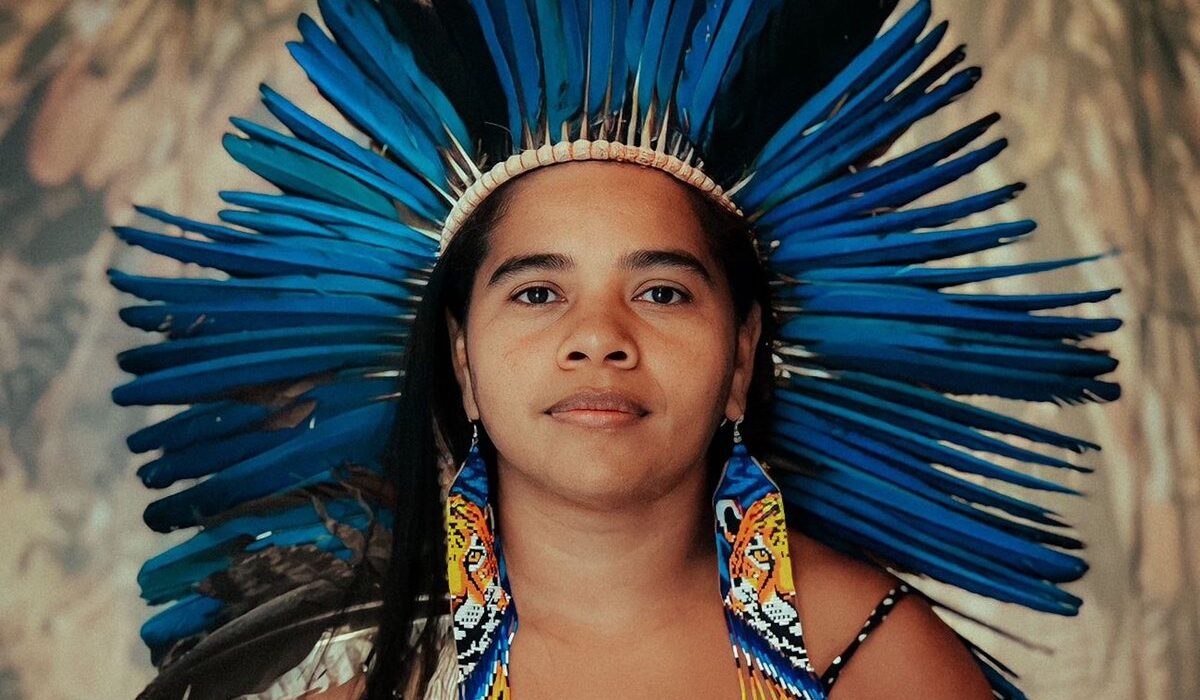The Brazilian Indigenous artist and activist Glicéria Tupinambá will take over the Brazilian pavilion in the 2024 edition of the Venice Biennale. Three Brazilian Indigenous artists will curate the pavilion: Arissana Pataxó, Denilson Baniwa and Gustavo Caboco Wapichana.
Tupinambá (also known as Célia Tupinambá) was born in 1982 in the Serra do Padeiro, one of several villages that form the Tupinambá Indigenous Land of Olivença in southern Bahia. She considers the culture and plight of Brazilian Indigenous communities in her work, and has spearheaded several activist interventions and artworks related to Tupinambá heritage and the demarcation of Tupinambá lands.
The Tupinambá people are one of several Tupi cultures that inhabited the eastern Brazilian coast before Portuguese colonisation. The Tupinambá, in particular, were long considered extinct. The tribe was not federally recognised until 2002, and continues to battle legislation that legalises encroachment on their native territories.
Much of the artist’s past work has centred on the revitalisation of ancient Tupinambá knowledge. Recent works have focused on recovering the production of Tupinambá mantles, a shamanic ritualistic object that was traditionally made through a distinct process involving the weaving of natural fibers, scarlet ibis feathers, and feathers from other birds, some whose colours were modified through the featherwork technique known as tapirage, in which the melanin of captive birds’ feathers were suppressed so their feathers could regrow with yellow and reddish hues. As her works chronicle, these vibrant Tupinambá mantles were avidly collected as part of the burgeoning curio trade in Latin America that emerged after European contact, and are emblematic of the fraught entanglement of European and Indigenous cultures in Brazil and the subsequent ethnographic framing of religious Brazilian Indigenous objects.
The artist explores related themes in the film Quando o Manto Fala e o Que o Manto Diz (When the Cloak Speaks and What the Cloak Says) (2023), which premiered last month at the São Paulo Museum of Art (Masp). Made in collaboration with the director Alexandre Mortagua, the film is overlaid with poetic narration and follows Tupinambá women through the process of creating a mantle, from the construction of the netting to the application of the feathers.
Pertinent to Tupinambá’s work, a rare example of a Tupinambá mantle made in the colonial period was returned to Brazil over the summer after being held at the Nationalmuseet in Denmark since 1689. It is one of 11 known existing mantles from the era, the rest of which are still held in European collections. The mantle will join the collection of the National Museum in Rio de Janeiro, which is working to rebuild and expand its national holdings after an electrical fire gutted the institution and most of its collection in 2018.
Tupinambá’s presentation in the next Venice Biennale is titled Ka’a Pûera: nós somos pássaros que andam (Ka’a Pûera: We are Walking Birds) and will investigate the sacred object through a film of the same title. The Brazilian pavilion, which has been symbolically renamed the “Hãhãwpuá Pavilion”, a term that references ancestral Indigenous lands, will also feature other works critiquing subjects related to Indigenous resurgence and resilience.
“Ka’a Puera are ancient forests that were cut down to make fields, (…) but is also known by the Tupinambá people as a small bird that lives in dense forests, its brown, orange and gray feathers camouflaging the bird on the forest floor,” the co-curators write in a joint statement. The double meaning of the exhibition’s title aims to honour communities “whose territorial rights have been violated, but who call us to resistance”.
Prior to her Venice Biennale representation, Tupinambá received the 2023 PIPA Prize, one of the most prestigious art awards in Brazil. Her past projects include the acclaimed 2015 film Voz Das Mulheres Indígenas (Voice of Indigenous Women).
Tupinambá was previously a professor at the Tupinambá da Serra do Padeiro Indigenous State College, and is pursuing a Master’s degree in social anthropology at the Federal University of Rio de Janeiro. She has held several leadership roles in Indigenous rights organisations and has been criminalised for her activism; in 2010, she and other activists were imprisoned after delivering an official message to then-president Luiz Inácio Lula da Silva (who is now serving a second presidential term) calling for the reinforcement of demarcation efforts.
In addition to aligning with the next Venice Biennale’s overarching theme Foreigners Everywhere, Tupinambá’s selection underscores the momentum within the Brazilian arts sector to champion Indigenous histories, from the latest edition of the Bienal de São Paulo’s predominant focus on Indigenous artists to Masp’s current annual curatorial programme, Indigenous Histories. The 60th edition of the Venice Biennale (20 April-24 November 2024) is being curated by Adriano Pedrosa, the artistic director of Masp and the first Latin American curator to ever lead the biennial.

